Simon Rattle leads a powerful, prescient evening of Weill, plus the best of April’s classical concerts
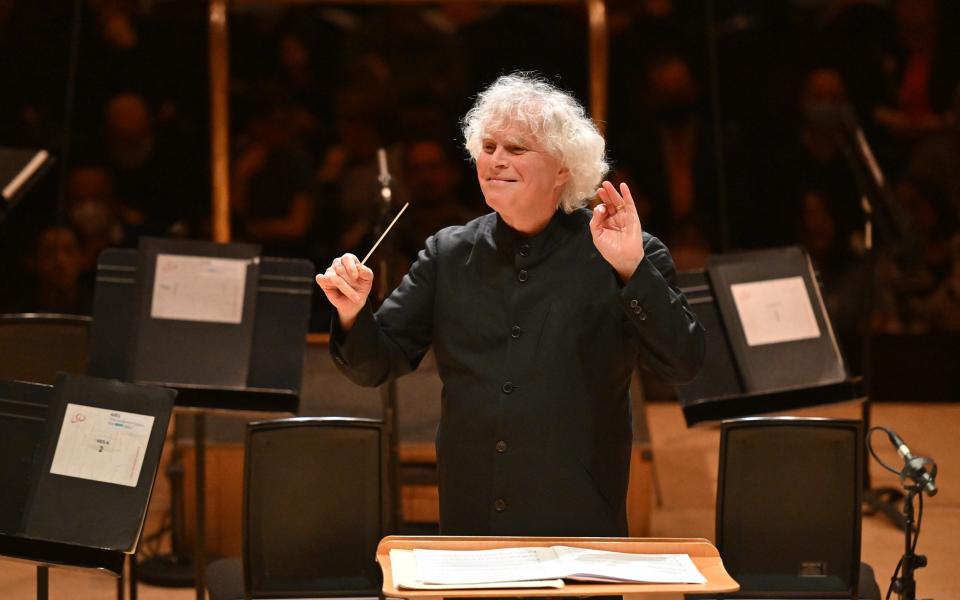
LSO/Rattle, Barbican ★★★★☆
Music from an age of anxiety revisited in a time of trouble: Simon Rattle's latest programme with the London Symphony Orchestra was devoted entirely to the music of Kurt Weill, and dominated by pieces from the period before teh Second World War. This concert was announced a long time ago and planned much earlier still – in the light of current events it all felt very prescient indeed.
Perhaps the most rarely heard of all the pieces on the programme was also the earliest. Vom Tod im Wald (Death in the Forest), a short 1927 cantata for baritone and just ten woodwind and brass instruments, sits far from the familiar Weill worlds of the Berlin cabaret and Broadway musical. A Bertolt Brecht setting that tells of a murder in a forest near the Mississippi, the work is stark and atonal. Florian Boesch projected the half-spoken, half-sung Sprechstimme with potent incision, and together with Rattle and the players found the transcendence of the ending.
The best-known work of the evening was the Little Threepenny Music (1929), the suite drawn from the previous year's Dreigroschenoper. Its music evokes the cabaret world of Berlin – a city more recently adopted as home by Rattle – and the Overture, with its coiling contrapuntal lines, was full of pungency and punch. The suite includes the famous Mack the Knife, its tune first heard on a muted trombone, but other numbers convey real tenderness. Not every number absolutely calls for the intervention of a conductor, yet Otto Klemperer, no less, took charge of the premiere; here Rattle made his mark, building up the finale impressively towards the chorale, where the accordion adds extra richness.
A counterweight to this was the Brecht-Weill Seven Deadly Sins, dating from the fateful year of 1933 (when Hitler consolidated his power). In the leading role of Anna, Magdalena Kožená was wonderfully engaging even if ultimately the music might call for a less polite singer. Kožená, who first came to attention as a Baroque specialist, has always resisted easy categorisation, and here her soft-grained mezzo had just enough edge. Making up a taut quartet around her, Andrew Staples, Alessandro Fisher, Ross Ramgobin and Boesch sang with sardonic humour. Rattle drove the orchestra along, the music surging along on its short tour of America in which different vices are matched to different cities.
American references in Weill's earlier works are prophetic perhaps of his own final years in the USA, and this all-Weill programme would not have felt balanced without some of the postwar pieces. Unease still lurked, not least in Sam Kaplan's haunting soliloquy "Lonely House" from the Broadway opera Street Scene; Staples supplied a ringing tenor, and the orchestral atmosphere made one long to hear Rattle conduct the whole work.
From the same period, we also heard two of the Four Walt Whitman Songs. Ramgobin's splendid baritone was maybe too cultivated for the martial tone of "Beat! Beat! Drums!", but Staples caught the melancholy of "Dirge for Two Veterans". Whitman's poems recall the Civil War, and war never seemed far away on this programme. JA
The LSO’s season continues; lso.co.uk
Renaud Capuçon and Friends, Aix Easter Festival ★★★★★
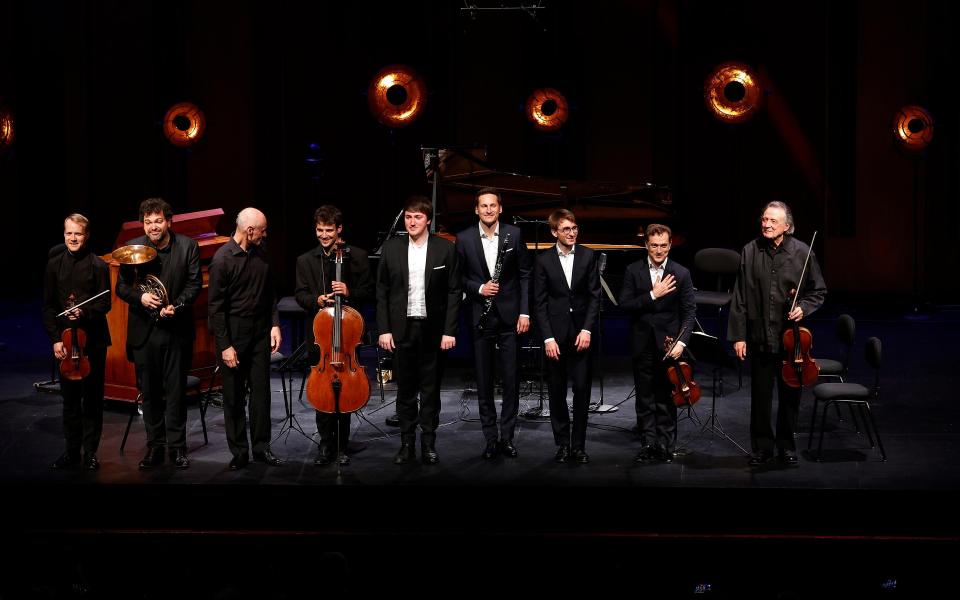
They do things in proper French style in Aix. When I asked Renaud Capuçon, the great violinist and director of the Easter Festival, how he makes his programming decisions, he replied: “I do it like a chef mixing his sauces.”
The result is unashamed high-art, chosen from the familiar masterworks of the classical tradition, with an emphasis on young French talent as well as international stars. It wouldn’t meet Anglo-Saxon standards of diversity and inclusivity, but thanks to the generosity of the Festival’s sponsor, the French bank CIC, Capuçon has been able to keep ticket prices low, and offer one concert free to Aix residents. In its nine years of existence the festival has won a place at the top table of European festivals, well worth making a trip for, and it’s also an excellent platform for emerging French talent we can hope to see in the UK before long.
Best of all, the concerts themselves have rarely dipped below the spectacular. I’ve heard some wonderful things, above all a spell-binding concert in the Cathédrale Saint-Sauveur from Raphaël Pichon and his 40-strong choir, Pygmalion. The climax of Richard Strauss’s late part-song Der Abend (The Evening) was so ecstatically intense that I thought the ancient windows would shatter.
And so, while it was an unseasonably chilly and rainy week in Aix, nothing could dampen the spirits of the packed audience at the Grand Théâtre du Provence for the final concert of the Festival. As always, a Lully march was played over speakers in the foyer, to encourage us to take our seats; afterwards, a glass of champagne was offered to everyone.
The concert itself, from “Renaud Capuçon and friends”, at times rose to similar ecstatic heights. The concert contained just one work, the Seventh Symphony of Anton Bruckner, in a chamber version for nine players made more than a century ago. You might think shrinking one of the grandest symphonies ever written, with a famous slow movement that creates an oceanic depth of feeling, to the dimensions of a Viennese salon would be a poor substitute for the real thing. In fact, it was a revelation. The arrangement, by three brilliant pupils of Arnold Schoenberg – the greatest composition teacher of the 20th century – was so brilliantly done that it felt like a complete imaginative recreation, on a par with a great film director reimagining a great stage play.
Some aspects of this new version were easy to revel in, like the delicious sound of the harmonium, which sounded sometimes cosily domestic and sometimes mysterious. Because the string parts were taken by solo players rather than the usual dozen or more, the music’s charming Schubert-like lilt, usually hidden under the forbiddingly massive sound of a full orchestra, could shine through. The extraordinary thing was the way in which the sound was sharply analytic, like an X-ray of the music and yet sweetly intimate at the same time.
As for the playing of “Capuçon and friends”, it was a marvel. Those friends included some of the best soloists and orchestra principal players in Europe, including a principal violinist (Christoph Koncz) and first clarinettist (Daniel Ottensamer) of the Vienna Philharmonic Orchestra. They caught the intimacy and lyricism of the new version beautifully, though that was the easy part. The real challenge came in the more grandiose moments where nine people had to create an effect of awe-inspiring massiveness. Sometimes this was in pianissimo, suggesting a huge boulder balanced on its tip; sometimes it was in heaven-storming fortissimo. It was a blazing ending to a Festival that never failed to delight. IH
The 2023 Easter Festival in Aix-en-Provence will take place from March 31 to April 16. Info: festivalpaques.com
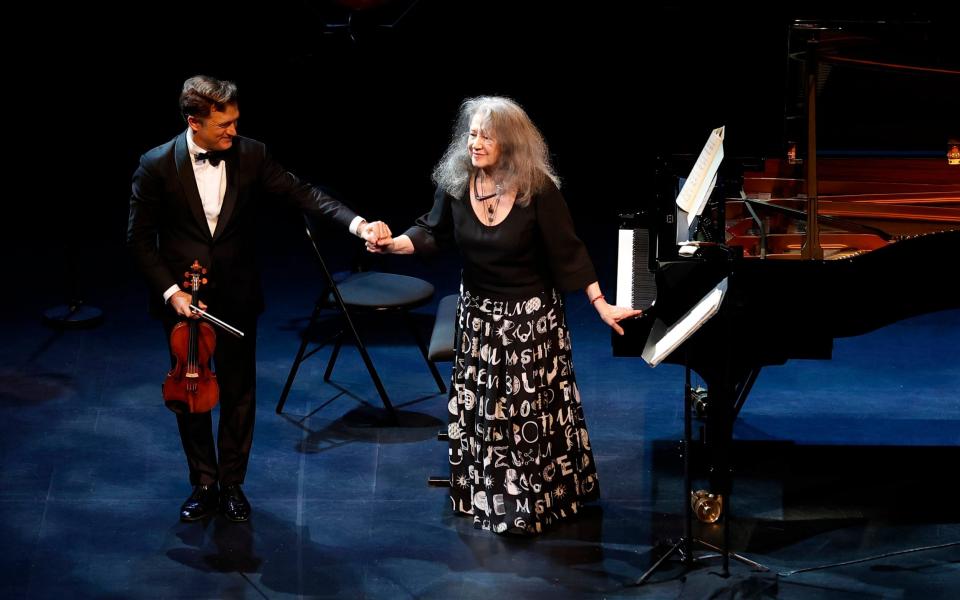
Renaud Capuçon/Martha Argerich, Aix Easter Festival ★★★★☆
There’s been no shortage of big names at this year’s Aix Easter Festival: Barbara Hannigan, Maria João Pires, Yuja Wang, Juan Diego Flórez. But the concert on the penultimate day from violinist and festival director Renaud Capuçon and pianist Martha Argerich felt like the festival’s hottest ticket.
The first is youngish, always perfectly tailored, playing with an old-style richness of tone and an impetuous way of almost-anticipating the pulse; the other is…Well, it would be ungallant to say “old”, and in any case there is something mysteriously ageless about Martha Argerich, even though her 81st birthday is not far off. She’s presented the same appearance of artless almost-dishevellment for a quarter of a century, her long grey locks flying as she attacks a chord fortissimo. She too has a wonderful quality of impetuousness, but with her it often registers as a startling switch of emotional tone, done with such utter decisiveness you’re swept along by it.
So was this concert a meeting of opposites or of like minds? It was actually a bit of both, which is what made it so fascinating. The two performers chose an absolutely copper-bottomed programme of 19th-century masterpieces by Beethoven, Schumann and César Franck, so no surprises there. Schumann’s A minor sonata is a perfect expression of his genius, and yet somehow it’s failed to become genuinely popular. The opening melody is typically Schumannesque, passionate but also anxious, the surging harmonies in the piano unsure of their direction, but there was nothing indecisive in the way Argerich expressed that quality.
The extraordinary thing was that she achieved all this while playing sotto voce. The idea of a “passionate murmur” may seem a contradiction in terms, but somehow Argerich expressed it, and Capuçon followed suit. Although the familiar marks of his playing were there – bending the pulse in a subtle yet imperious way – everything seemed muted. In the tender second movement this impression of music conjured from muted colours was even more pronounced. The final movement – far from being a rousing finale – is a sort of hob-goblin dance, with an enticing twilight quality which in this performance seemed unusually intense.
Finding such a shadowy, elfin sound for Schumann’s piece served the music very well but it was also strategically shrewd, because it made the emphatic daylight of Beethoven’s famous Kreutzer sonata stand out in sharp relief. What makes the opening movement so powerful is the contrast between different emotional states all treading on each other’s heels; the grandly statuesque opening (played here with immaculate strength by Capuçon) and the furious energy that follows it, and then the big pleadingly romantic melody. It was as overwhelming as a tidal wave, but the rest of the sonata wasn’t always so wonderful. Argerich’s rendition of the immense melody of the slow movement seemed unfocused, though the variations were beautifully poetic.
Finally came the violin sonata by César Franck, a piece which catches the composer’s unique emotional world of sacred mystery and romantic effusion better than any other. This performance was even more interestingly coloured than the Schumann sonata. Argerich made the soft introduction sound like a mysterious gleaming emanation from some other world, and not until Capuçon joined her did the music seem quite real.
Throughout there were numerous telling subtleties. The tragic oration of the third movement had an unusually soft meditative tone. In the onrush of the final movement Argerich’s sudden surges of tempo sometimes seemed to take Capuçon by surprise, though he’s such a quick-fitted artist he managed to almost-hide the fact. And overall this final journey to the closing major-key ecstasy – heavenly or romantic, one can never be sure – was perfectly calibrated to sweep us off our feet. It was an evening of imperiously brilliant music-making, but it was the perfect tender simplicity of the third encore by Austrian composer Maria Theresia von Paradis which finally melted us and brought us all to our feet. IH
National Youth Orchestra/Prieto, Festival Hall ★★★★★
Ever since the near-riot at its premiere in Paris in 1913, Stravinsky's Rite of Spring has been seen as a challenging piece. But while it no longer represents something of a terror to orchestras, not everyone plays this music with such comfortable panache as the National Youth Orchestra showed here on its latest outing to the Southbank Centre. For once, the huge size of the NYO was no obstacle to clarity: Stravinsky's thicker textures were enriched with heavy weight (seven bassoons, for example) in the murmurs and grunts that accompany the score's awakening, yet the playing also had incisive bite.
Credit for this is equally due to the conductor Carlos Miguel Prieto, whose fluid yet clear baton gave these players the best possible support. No stranger to the NYO, the Mexican conductor once again established an obvious rapport with the young musicians that gave them expressive freedom. Yet the essential discipline was all there, and Stravinsky's score was underpinned by an impressively rock-solid principal timpanist. There was tenderness in the playing at the start of Part 2, before the convulsive rhythms took over again in a high-precision performance, an experience these musicians – Britain's biggest concentration of young talent – will surely never forget.
The Rite of Spring's place as a touchstone for modern music and as a work that destroyed old divisions between "classical" and "folk" traditions made it an ideal centrepiece for the NYO's concert, given under the banner of "Open Up: Running Riot" and which aimed to disrupt the usual boundaries that define orchestral concerts. Having flirted with banality in some recent commissions, the NYO wisely turned to two tried-and-tested yet still new works that embrace other musical cultures.
Gabriela Ortiz's Téenek – Invenciones de Territorio takes its title from the name of the language spoken in the northern Mexican region of Huasteca. It opened the concert, unannounced and at first conductorless, with the bright wooden clicking of several pairs of claves silencing the audience and their rhythms spreading through the orchestra as the players got into the groove. A clarinet solo referenced The Rite of Spring, and once each section of the orchestra had been highlighted, Prieto crept on and steered the piece's more complex second half – well, more than half, as Ortiz spreads her material a little too thinly. Yet for all its length, the kinetic energy never lagged.
The evening's soloist, Sandeep Das, has described the Tabla Concerto by the Sri Lankan-born Canadian Dinuk Wijeratne as "simply the best western classical piece written for my instrument", and it was certainly compelling here. Stark string canons launch the first movement, which is ignited by the lively intervention of the tabla, a pair of hand drums of almost ventriloquistic quality. Starting with a muted trumpet solo, the compact second movement has a lyrical flow picked up by the whole orchestra, and in the long third movement Das added vocal interventions to his charismatic virtuosity.
The concert travelled far and wide, with its dedication to the young musicians of Ukraine being expressed in a haunting Ukrainian folk song, played by a septet and eventually taken up by the whole orchestra humming along. With energy to burn even after the Stravinsky, it was back to Mexico for an energetic encore, taking a leaf out of Gustavo Dudamel's book with choreographed high jinks. JA
Hear this concert again for 30 days on the BBC Sounds app
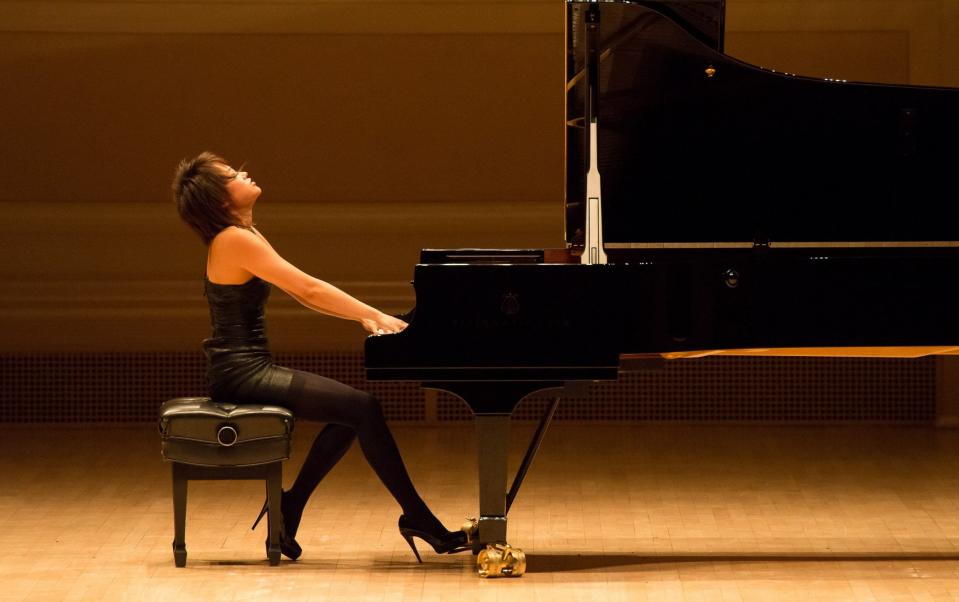
Yuja Wang, Aix Easter Festival ★★★★☆
It’s said the legendary violinist Fritz Kreisler could play so perfectly he sometimes played his octaves slightly out of tune, just so his listeners would actually notice he was playing them. There were moments on Monday night during the tremendous recital by Chinese-American pianist Yuja Wang when I almost wished she would do something similar – hit a wrong note, or at least pretend there were some taxing moments, just to bring home to us how monstrously hard her programme was. Not to mention the eight encores.
As it was, I was so dazzled by the sheer physical brilliance of her recital it was hard to perceive the musicality underneath, even though that was considerable. The only disappointment came at the beginning, with Beethoven’s wonderful 18th sonata. Of course Wang despatched the dancing left-hand part of the Scherzo with perfect light-fingered precision, and of course she gave the mad helter-skelter of the finale the proper Beethovenian fire. But the real joy of the sonata is in the first movement, which begins with a throw-away gesture, gathers to a big moment of expectation and then humorously deflates itself, all in the space of about 20 seconds. In Wang’s hands, all this felt dutiful, like someone repeating a joke they didn’t actually find funny.
It’s not the first time I’ve felt bafflement in Wang’s Beethoven performances, and maybe it’s time to accept Beethoven is her blind spot. Which is ok – every performer must be allowed one at least. The insight and poetry elsewhere more than made up for it, not least in the suite by Arnold Schoenberg that came next. This bizarre amalgam of neo-classical gavottes and minuets with Schoenberg’s own strict so-called “12-note” system can sound as dry as dust, but Wang filled it with fascinating half-lights and feline grace.
Then came two of the appallingly hard Piano Études by György Ligeti. Like all the best piano studies, these turn a technical exercise into a poetic evocation, a transformation managed beautifully by Wang. Autumn in Warsaw felt like a despairing and never-ending rain of dead leaves, while The Devil’s Staircase bounded upwards with a sort of gleeful horror.
After the interval, the tone lightened with Scriabin’s 3rd Sonata, a piece still suffused with the delicate Chopinesque poetry of his early works. The exquisite dreaminess of the second movement was actually the evening’s best moment. The two deceptively relaxed-sounding evocations of Spanish landscapes by Albeniz weren’t quite as lazily seductive as they needed to be – Wang doesn’t do lazy – but the following jazz Préludes by the brilliant Russian composer Nikolai Kapoustin were fabulously sharp and sassy.
Finally came those eight encores, each more brilliant than the one before. The best of them was actually the least impressive technically, a Song without Words by Mendelssohn which – like the Scriabin slow movement we heard earlier – brought out Wang’s special talent for gilding something soft and gentle with mysterious half-lights. It was another proof that although brilliance may be Wang’s calling-card, there’s so much more to her than that. IH
Yuja Wang appears at the Barbican in London on April 20; barbican.org.uk The Aix Easter Festival continues until April 24; festivalpaques.com
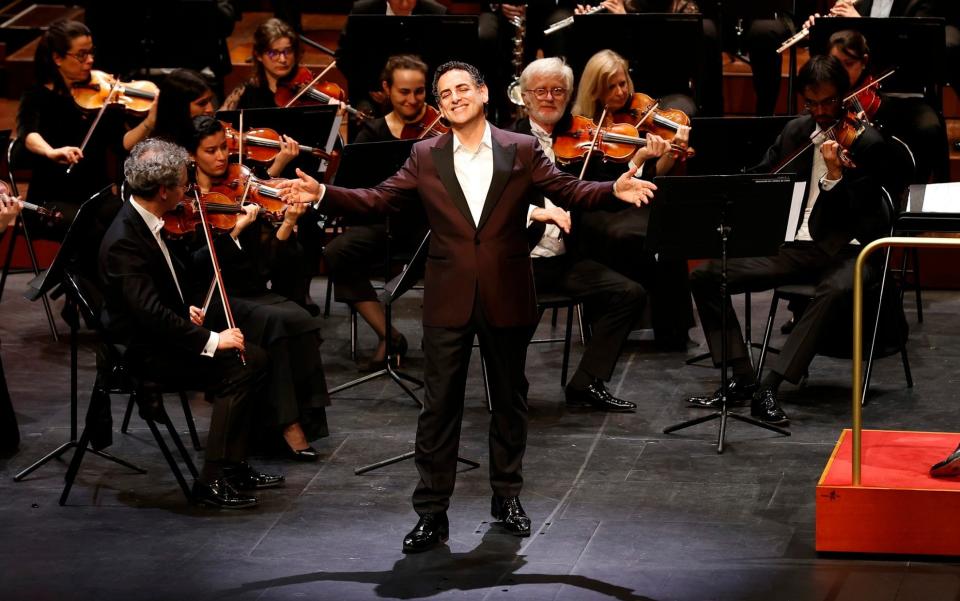
Kovacevich/Juan Diego Florez, Aix Easter Festival ★★★★☆
Ivan HewettAix-en-Provence hardly needs a festival to be lovely in spring. The peonies and fruit trees are in bloom, you can smell the rosemary, and the Provencal hills shimmer in the morning heat-haze.
Still the newish Aix Easter Festival is a wonderful thing. Founded in 2013 and directed by famed violinist Renaud Capuçon, the aim is to be a Salzburg festival in the sun, with the best international artists alongside local performing groups. Last night, in the concert hall in the city’s eye-catchingly modernist Conservatoire (which began life in the same year as the festival) the venerable American-born British-domiciled pianist Stephen Kovacevich played Beethoven’s penultimate and Schubert’s last sonatas, followed up by star tenor Juan Diego Flórez singing alongside rising soprano Marina Monzó.
Both piano works seem to come from some remote region beyond earthly cares, and before beginning both pieces Kovacevich closed his eyes and frowned, as if measuring that huge spiritual distance. The performances when they emerged were very gentle and meditative, and, it has to be admitted, sometimes hesitant. The Kovacevich who used to electrify us with his biting incisive performances of Bartok and the “heroic” middle-period Beethoven seemed a distant memory. Yet there was a wisdom in Kovacevich’s delicate balancing of the inner parts, and the way the final fugue in Beethoven’s sonata emerged from pedalled haze into blazing clarity was wonderful. In the closing pages of the finale of Schubert’s sonata, which he flung off with a “to hell with it” recklessness, something of Kovacevich’s old fire reappeared.
The following concert was very different, scaling no spiritual heights but offering a breath-taking display of vocal pyrotechnics and extravagantly romantic emotions, expressed through operatic arias and duets. The two artists were at very different levels in terms of reputation. Peruvian tenor Juan Diego Flórez has been a superstar for over quarter of a century thanks to his blazingly heroic light tenor, an incredible vocal agility that’s perfect for Italian bel canto repertoire, and a top C to die for. Spanish soprano Marina Monzó on the other hand is only in her late 20s, and though she’s now performing Rossini and Verdi roles to great acclaim has hardly been seen in the UK.
That could change, as she’s clearly a huge talent. Of course Flórez has the advantage of an irresistible swagger in his singing that comes from years of experience. So even when he struck a tender note, as he did in his aria from Donizetti’s Linda di Chamonix, he still wowed us with the high-wire virtuosity of the final high note, which faded away to electrifying effect. But the voice doesn’t have quite the body and sheen it had twenty years ago.
Monzó’s delicate soprano on the other hand is in its perfect, springtime bloom, and although her vocal agility is spellbinding she doesn’t let it take centre-stage. She uses it instead to express real feeling, so that even Gounod’s sugary aria “Je veux vivre” from his Roméo et Juliette took on a real power to move. As well as being aurally seductive the contrast between the two singers also fitted the traditional gender stereotypes of romantic opera to a T, which is why their final duet, the lovely O soave fanciulla from Puccini’s La Bohème absolutely brought the house down. IH
The Aix Easter Festival continues until 24 April; festivalpaques.com

Passiontide at Merton, Merton College Oxford Chapel ★★★★☆
Merton College’s annual three-day celebration of Easter music, which mingles sung church services with straight concerts of sacred music appropriate to the season, is in one respect eye-catchingly new. The choir of Merton College, which does the lion’s share of the music-making, was not founded until 2008, and the decision to recruit women to sing the high parts instead of boy trebles was certainly a huge innovation. At the time, it felt like an earthquake.
Yet sitting in the beautiful chapel, watching the rays from the setting sun rise slowly up the walls, listening to the music amid the ancient language of Evensong and Compline (no modern rewritings of the old texts are permitted here), we felt immersed in something age-old. The poetry of the words was a large part of the artistic experience (“Keep me as the apple of an eye, Hide me under the shadow of thy wings” were two luminous lines sung by the choir during Compline), and they lent their glow to the music-making.
In the Evensong, much of the music was relatively recent, with Herbert Howells’s big Magnificat setting from his Gloucester Service alongside Gerald Finzi’s The Full Final Sacrifice. They were wonderfully sung, the choir’s radiant fullness of tone yielding nothing to Oxford’s more famous ancient choral foundations. The only jarring note came with Cheryl Frances-Hoad’s Merton Responses from 2021. These little one-line responses to the priest’s prayers were brilliant little musical inventions, each moving from complexity and tension to almost-resolution. But that was actually a problem. The music for Responses should modestly gild the words, and not draw attention to itself.
A few hours earlier, in the concert given in the chapel by the all-male vocal group The Gesualdo Six, we’d heard another brilliant invention by Frances-Hoad, an invocation of a mythic wood filled with scraps of prayers coming from afar, and this time it felt exactly right. Alongside it were a moving evocation of Christ’s Agony in the Garden by Judith Bingham, and masterpieces from the Renaissance. With only one voice to each part, the music took on an intimate glow, but there was no shortage of intensity and anguish.
The director Owain Park wasn’t afraid to ruffle the music’s beautiful surface with startling changes of tempo and dramatic use of dynamic contrast. And yet, the singing was so refined and perfectly balanced we could really relish the tiny details that made the expressive worlds of each composer so distinctive: troubled and subjective in Gesualdo’s Tenebrae Responseries, more restrained and intricate in Tallis’s Lamentations, gravely sorrowful in Byrd’s Miserere Mei. Heard in the concert hall, the Gesualdo Six are wonderful; here, surrounded by the ancient stone of Merton College Chapel, they seemed even more so. IH
The Gesualdo Six perform at St Martin-in-the-Fields London on April 12; stmartin-in-the-fields.org

 Yahoo News
Yahoo News 